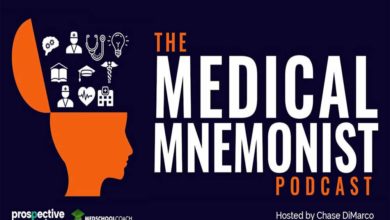ATOM BOMB: The Memory Palace is the sixth episode in a miniseries on medical mnemonics. In this episode, Chase DiMarco talks about mind palaces and how to create one for your medical studies. By combining all of the previously learned mnemonics into a memory palace, you can recall dense chunks of information with more ease.
- [01:27] What is a memory palace?
- [04:02] Creating a memory palace
- [09:46] Adding visual markers to your mind palace
- [16:03] Homework Exercise
The Memory Palace
A mind palace is a memory technique that involves the use of real or fictional locations. To create one, choose a location that you’re familiar with. You should be able to picture the general layout and the objects within the place. In your chosen “palace”, there are macro stations or large segments that are grouped together. And then there are micro stations or the distinguishing features of a location.
After visualizing the space, it’s time to envision the pathway. Imagine how you would move through the memory palace. It would be better if it’s a path that you can effortlessly follow every time. In a previous episode with Dr. Anthony Metivier, he suggests starting from a dead end. In doing so, you have more ways to explore your mind palace. To help you visualize the creation of memory palaces, watch Chase’s YouTube tutorial.
It’s a good idea to sketch out your chosen location to test your knowledge of it. The drawing serves as a reference point that can be used when planning your memory palace. By planning, you can ensure that there is enough space for the visual markers and mnemonics. Insert mind maps, peg systems, and the other tools we’ve learned about in the micro stations. Classify them in a way that makes sense to you. You can even combine different memory palaces together for more complex subjects.
The mind palace technique is powerful because it makes use of our strong visual and spatial memories. Walk through your memory palace regularly. In time, you’ll be able to review a lot of material quickly through this method.
Homework
- Make a list of locations you can visualize in detail.
- Practice creating a memory palace. Pick a random location and topic to start with. Sketch out the site on your journal. Categorize the main themes into macro stations. Create a list or table for the sub topics and assign a visual mnemonic to each one. Insert the visual markers in the micro stations within the appropriate macro stations.
- Include your memory palace in your spaced repetition practice.
Listen to our previous episode with Dr. Lev Goldentouch to know about other advanced mnemonic techniques. For more study tips, grab a copy of Read This Before Medical School. Don’t forget to leave a rating!
Share your experiences, tips, and suggestions to [email protected]. Or you can directly reach out to Chase on LinkedIn, Twitter, or Instagram. Join the Medical Mnemonist Master Mind Facebook group and find our Blog posts, Podcasts, and other Resources at FreeMedEd.org!
